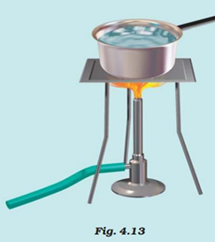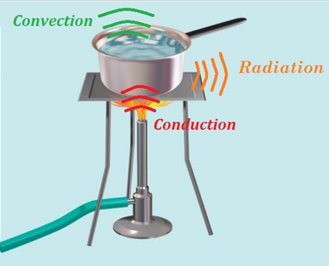NCERT Solutions for Class 7 Science Chapter 4 Heat
NCERT Solutions for CBSE Class 7 Science Chapter 4 Heat are given below. These solutions help students to clear their doubts and to obtain good marks in final exam. Class 7 Science NCERT questions and answers provided in this article are strictly based on the CBSE syllabus and curriculum.
Class 7 Science Chapter 4 Heat NCERT Solutions
Class 7 NCERT Solutions for Science Chapter 4 includes all the intext and exercise questions. All these questions are solved by experts with a detailed explanation that will help students complete their assignments and homework.
EXERCISES
Question 1: State similarities and differences between the laboratory thermometer and the clinical thermometer.
Answer: Similarities:
- Working principle of both the thermometer is same.
- Both are used to measure temperature.
- Both have a thick walled glass tube enclosing a fine uniform bore capillary tube.
- Mercury is used in both thermometers to measure temperature.
- Both have Celsius and Fahrenheit markings.
Differences:
- Laboratory thermometer is used to measure temperature of different objects in factories and laboratory where as clinical thermometer is used to measure the temperature of human beings only.
- Generally, laboratory thermometer has temperature range from −10℃ to 110℃ whereas clinical thermometer has temperature range from 35℃ to 42℃.
- Usually laboratory thermometer does not have any constriction whereas clinical thermometer has the small constriction near the mercury bulb.
- Laboratory thermometer has to be kept upright while taking the reading whereas clinical thermometer can be tilted while taking reading.
Or
Differences
| Clinical Thermometer | Laboratory thermometer |
| Temperature range is 35° to 42°C | Temperature range is -10° to 110°C |
| Used to measure human body temperature | Used to measure temperature in the laboratory |
| It has kink which prevents immediate backflow of mercury | It does not have a kink |
Question 2: Give two examples each of conductors and insulators of heat.
Answer: Two examples of conductors of heat are:
(i) Aluminium
(ii) Iron
Two examples of insulators of heat are:
(i) Wood
(ii) Plastic
Question 3: Fill in the blanks:
(a) The hotness of an object is determined by its __________.
(b) Temperature of boiling water cannot be measured by a _____________ thermometer.
(c) Temperature is measured in degree ______________.
(d) No medium is required for transfer of heat by the process of __________.
(e) A cold steel spoon is dipped in a cup of hot milk. Heat is transferred to its other end by the process of ______________.
(f) Clothes of ______________ colours absorb more heat better than clothes of light colours.
Answer: (a) The hotness of an object is determined by its temperature.
(b) Temperature of boiling water cannot be measured by a clinical thermometer.
(c) Temperature is measured in degree Celcius.
(d) No medium is required for transfer of heat by the process of radiation.
(e) A cold steel spoon is dipped in a cup of hot milk. Heat is transferred to its other end by the process of conduction.
(f) Clothes of dark colours absorb more heat better than clothes of light colours.
Question 4: Match the following:
| Column-I | Column-II |
| (i) Land breeze blows during | (a) summer |
| (ii) Sea breeze blows during | (b) winter |
| (iii) Dark coloured clothes are preferred during | (c) day |
| (iv) Light coloured clothes are preferred during | (d) night |
Answer:
| Column-I | Column-II |
| (i) The land breeze blows during | (d) night |
| (ii) The sea breeze blows during | (c) day |
| (iii) Dark coloured clothes are preferred during | (b) winter |
| (iv) Light coloured clothes are preferred during | (a) summer |
Question 5: Discuss why wearing more layers of clothing during winter keeps us warmer than wearing just one thick piece of clothing.
Answer: More layers of clothing during winter keeps us warmer than wearing just one thick piece of clothing because air gets trapped in-between layer. As air is a bad conductor of heat it does not allow the escape of the heat from the body.
Question 6: Look at Fig. 4.13. Mark where the heat is being transferred by conduction, by convection and by radiation.

Answer:

Question 7: In places of hot climate it is advised that the outer walls of houses be painted white. Explain.
Answer: In places of hot climate, it is advised to paint the outer walls of houses as white because a light colour such as white reflects back most of the heat that falls on it. Hence, a light colour tends to keep the house cool.
Question 8: One litre of water at 30°C is mixed with one litre of water at 50°C. The temperature of the mixture will be
(a) 80°C
(b) more than 50°C but less than 80°C
(c) 20°C
(d) between 30°C and 50°C
Answer: (d) between 30°C and 50°C
Question 9: An iron ball at 40°C is dropped in a mug containing water at 40°C. The heat will
(a) flow from iron ball to water.
(b) not flow from iron ball to water or from water to iron ball.
(c) flow from water to iron ball.
(d) increase the temperature of both.
Answer: (b) not flow from iron ball to water or from water to iron ball.
Question 10: A wooden spoon is dipped in a cup of ice cream. Its other end
(a) becomes cold by the process of conduction.
(b) becomes cold by the process of convection.
(c) becomes cold by the process of radiation.
(d) does not become cold.
Answer: (d) does not become cold.
Question 11: Stainless steel pans are usually provided with copper bottoms. The reason for this could be that
(a) copper bottom makes the pan more durable.
(b) such pans appear colourful.
(c) copper is a better conductor of heat than the stainless steel.
(d) copper is easier to clean than the stainless steel.
Answer: (c) copper is a better conductor of heat than the stainless steel.